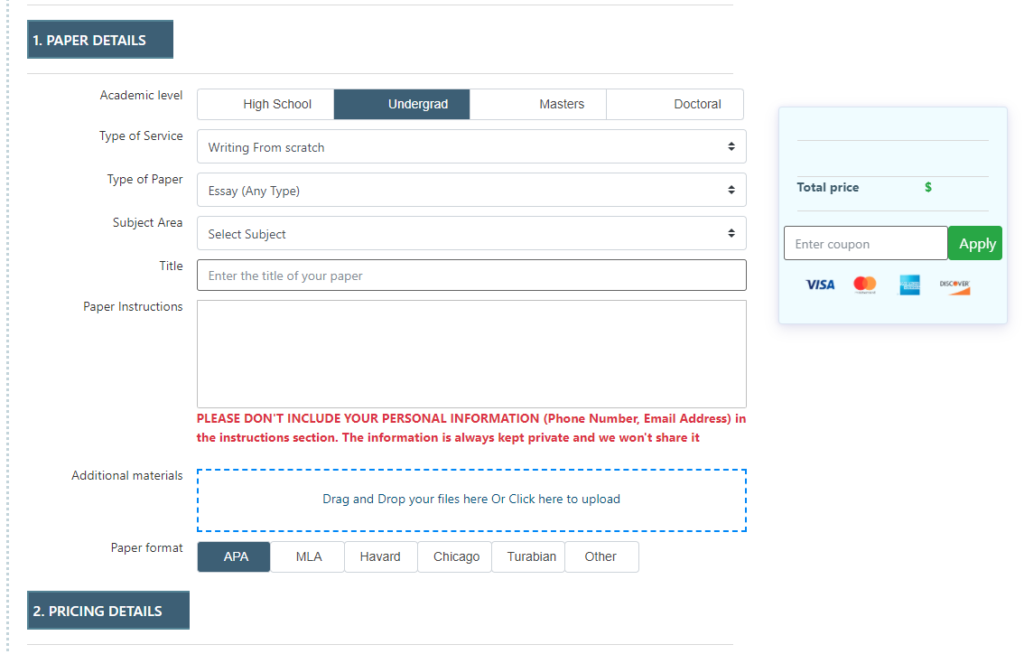Order Description
Filial Play Therapy and Cultural Diversity
Resources
€¢ Attributes and Evaluation of Discussion Contributions.
€¢ Professional Communications and Writing Guide.
€¢ Child€“Parent Relationship Training As Experienced by Hispanic Parents: A Phenomenological Study.
€¢ Filial Therapy: An Intervention for Parents of Children with Chronic Illness.
€¢ Filial Therapy with Immigrant Chinese Families.
Diversity Scenarios
Launch Presentation | Transcript
Click Launch Presentation to view the media piece Diversity Scenarios. In this piece, Dr. Ted Borkan, a Capella University faculty member, guides you
through a consideration of scenarios in which you respond to the concerns of caregivers from three different cultural backgrounds. This piece is the
basis for the discussion, and should be viewed before attempting to post.
In your post, develop your own guidelines for the appropriateness of filial play therapy as an intervention, including:
€¢ Situations in which you would:
o Recommend intervening with FPT.
o Hesitate to intervene with FPT.
o Not use FPT as an intervention.
€¢ Reasons for your decision in each type of situation.
€¢ Description of the process you would follow in cases in which you found you had initial doubts.
Diversity Scenarios
________________________________________
Introduction
Dr. Ted Borkan: Hi, I’m Dr. Ted Borkan, a faculty member in the Educational Psychology Specialization, and it’s my job to help you work through three
situations in which diverse clients might present special concerns. Each of these concerns might represent a type of issue that would make conducting
Filial Play Therapy difficult for a particular family. None of these, though, are obvious or definitive cases. In each case, it’s going to be your
job to weigh the factors involved, and to decide whether it makes good therapeutic sense to go ahead with a Filial Play Therapy intervention.
In each case, you’ll hear the initial reaction of parents or caregivers who have just heard your brief explanation of a recommendation to intervene
by means of Filial Play Therapy. You’ll have a chance to take a shot at responding to their concerns. Then, I’ll be back with you to point out some
contextual issues, and to suggest some aIDitional resources, that might help you think through the situation. Finally, before moving ahead to the
next scenario, we’ll suggest you make some notes toward your preparation of a discussion post on this topic.
Scenario 1
Hispanic parents whose four-year-old daughter has had some behavioral issues in the local Head Start program.
Mother (in Spanish €“ with translator repeating): I am not sure that I like the idea of being in a group. I can handle the behavior problems at home!
Dr. Borkan: Hispanics often prefer interpersonal relationships that are nurturing, loving, intimate, and respectful which is in line with the child-
centered principles of Filial Therapy. The cited article describes Filial Therapy with Hispanic families in a school setting. Here is a quote from
the article referenced on the screen: The support group format of CPRT attends to the cultural values of both personalismo and familia. The group
members, because of their cohesive and genuine qualities fostered through CPRT principles, are viewed by the members of the Hispanic culture as an
extension of their family environment.
Scenario 2
Caucasian parents of a four-year-old with asthma who is hospitalized frequently.
Father: Every moment is filled with teaching him how to take care of himself and my taking care of his needs. We just do not have time to play.
Dr. Borkan: Although the parents may really feel this way, it’s also possible that they are picturing a different kind of therapy session. Just to
make sure, you might want to provide a bit more information about the intervention, such as:
€¢ Play sessions are just 30 minutes a week.
€¢ The focus of your interaction during play is positive.
€¢ Play is being aIDed back to a life that otherwise may be filled with illness.
The cited article describes Filial Therapy with families with a chronically ill child. Here is a quote from the article referenced on the screen:
For the parents, there were many positive outcomes of the filial group. They reported significant changes in their relationships with their
children. All reported that the sessions had become important to both parent and child. Perhaps it is these qualitative changes that are the
significant results. They indicate that Filial Therapy can and does have a positive impact on children with chronic illness and their families.
Scenario 3
An immigrant Chinese family living in Canada for four years. The husband is still living in China. The child is six years old. The mother can speak
Cantonese and English.
Mother: Playing is a waste of time. Only work is meaningful.
Dr. Borkan: There is a stigma attached to mental illness and Chinese parents may be reluctant to seek help from professionals. Also, there is a high
level of stress related to separation from a spouse and entering a different culture. Parental control, obedience, strict discipline, filial piety,
respect for elders, family obligations, maintenance of harmony, and negation of conflict are often emphasized in Chinese parent-child relationships.
The cited article describes Filial Therapy with immigrant Chinese families. Here is a quote from the article referenced on the screen: However, the
Chinese culture assumes that parents take complete responsibility for their child’s development, and therefore, parents are very much involved in
their children’s decision-making process. Filial Therapy training helped these parents value their children’s growth, development, autonomy, and
maturity.
Conclusion
Dr. Borkan:So now you have heard from three sets of caregivers, reviewed relevant literature, and thought about issues in the context of each family
that might support Filial Play Therapy €“ or make it more difficult. It’s time for you to return to the courseroom and prepare your discussion post on
the topic of Diversity Scenarios. In your post, develop your own position on the appropriateness for Filial Play Therapy as an intervention,
including situations in which you would:
€¢ Recommend intervening with Filial Play Therapy.
€¢ Hesitate to intervene with Filial Play Therapy.
€¢ Not intervene with Filial Play Therapy.
Provide reasons for your position in each case.
________________________________________
RESOURCES:
Article 1
Garza, Y., Kinsworthy, S., & Watts, R. E. (2009). Child€“parent relationship training as experienced by Hispanic parents: A phenomenological study.
International Journal of Play Therapy, 18(4), 217-228.
Article 2
Glazer-Waldman, H. R., Zimmerman, J. E., Landreth, G. L., & Norton, D. (1992). Filial therapy: An intervention for parents of children with chronic
illness. International Journal of Play Therapy, 1(1), 31-42.
Article 3
Yuen, T., Landreth, G., & Baggerly, J. (2002). Filial therapy with immigrant Chinese families. International Journal of Play Therapy, 11(2), 63-90.
Use your Landreth & Bratton text, Child Parent Relationship Therapy (CPRT): A 10-Session Filial Therapy Model, to complete the following:
€¢ Read Chapter 21, Research Evidence for Child Parent Relationship Therapy (CPRT): A 10-Session Filial Therapy Model, pages 457€“481. This chapter
provides some of the research evidence for filial therapy, as well as the meta-analysis performed by Bratton on filial therapy research studies.
Use the Capella University Library to complete the following:
€¢ Read Guerney’s 2001 article, Child-Centered Play Therapy, from International Journal of Play Therapy, volume 10, issue 2, pages 13€“31. This
article explains the reasons for designing filial therapy using this theoretical orientation.
€¢ Read Cochran, Cochran, Nordling, McAdam, & Miller’s 2010 April article, Monitoring Two Boys’ Progress Through the Stages of Child-Centered Play
Therapy, from International Journal of Play Therapy, volume 19, issue 2, pages 105€“116. As an illustration of the therapy process using a child-
centered approach to therapy, this article helps us visualize why the approach works.
![]()








